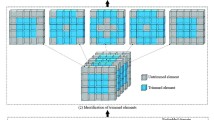Abstract
The aim of this paper was to present a tolerance modeling method of complex features. Geometric deviation of a characteristic/feature is divided into intrinsic deviation and situation deviation based on the new generation geometrical product specification in the paper. On the basis of vector parametric representation of theoretical surface, intrinsic deviation between substitute surface and ideal surface is described by vector function. Based on 3D rigid body kinematics, homogeneous transformation matrix-based method is used to describe the situation deviation of the substitute surface relative to the reference feature in Euclidean space. An example was given using the proposed modeling method.
Similar content being viewed by others
References
Bjorke O (1989) Computer aided tolerancing, 2nd edn. ASME, New York
Zhao X, Pasupathy TMK, Wilhelm RG (2006) Modeling and representation of geometric tolerances information in integrated measurement process. Comput Ind 57:319–330
Clement A, Desrochers A, Riviere A (1991) Theory and practice of 3D tolerancing for assembly. Proceedings of the 2nd CIRP seminar on computer aided tolerancing
Liu YS, Gao SM (2004) Variational geometry based tolerance pre-evaluation for pattern of holes. Int J Prod Res 36:1659–1676
Requicha AG (1983) Toward a theory of geometric tolerancing. Int J Rob Res 2:45–60
Requicha AG (1986) Representation of geometric features, tolerances and attributes in solid modelers based on constructive solid geometry. IEEE J Robot Autom 3:156–166
Requicha AG (1993) Mathematical definitions of tolerance specifications. Manuf Rev 6(4):269–274
Roy U, Liu R (1988) Feature-based representational scheme of a solid modular for providing dimensioning and tolerancing information. Rob Comput Integr Manuf 4:335–345
Jayaraman R, Srinivasan V (1989) Geometric tolerancing II: conditional tolerance. IBM J Res Dev 33:105–122
Jayaraman R, Srinivasan V (1989) Geometric tolerancing: I. Virtural boundary requirement. IBM J Res Dev 33:90–104
Hillyard RC, Braid IC (1978) Characterizing non-ideal shapes in terms of dimensions and tolerances. Comput Graph 12:234–238
Light R, Gossard D (1984) Modification of geometric models through variational geometry. CAD 14:209–214
Turner JU, Wozny MJ (1988) A mathematical theory of tolerances. In: Wozny MJ, McLaughlin HW, Encarnacao JL (eds) Geometric modeling for CAD applications. IFIP, North Holland
Turner JU, Wozny MJ (1990) The M-space theory of tolerances. Adv Des Autom 1:217–225
Clement A, Desrochers A, Riviere A (1991) Theory and practice of 3D tolerancing for assembly. Proceedings of the 2nd CIRP Seminars on Computer Aided Tolerancing, pp 1–8
Chase K, Gao J, Magelby S (1998) Including geometric feature variation in tolerance analysis of mechanical assemblies. IIE Trans 28:795–807
Shah JJ, Yan Y, Zhang BC (1998) Dimension and tolerance modeling and transformations in feature based design and manufacturing. J Intell Manuf 9:475–488
Bhide S, Davidson JK, Shah JJ (2001) Areal coordinates: the basis of a mathematical model for geometric tolerances. Proceedings of the 7th CIRP International Working Seminar on Computer Aided Tolerancing
Ameta G, Davidson JK, Shah JJ (2007) Tolerance-maps applied to a point-line cluster of features. Trans Am Soc Mech Eng 129(8):782–792
Roy U, Li B (1998) Representation and interpretation of geometric tolerances for polyhedral objects—I. Form tolerances. Comput Aided Des 30:151–161
Asante JN (2009) A small displacement torsor model for tolerance analysis in a workpiece–fixture assembly. Proc Inst Mech Eng B J Eng Manuf 233(8):1005–1020
Zhang KF, Li Y, Cheng H (2009) Modeling and analyzing approach of self-adaptively matching tolerance and performance. Comput Integr Manuf Syst CIMS 15(10):1956–1959 + 1978
Merkley K (1998) Tolerance analysis of compliant assemblies. PhD Dissertation, Brigham Young University, Utah
Qu JP (2001) Research and implement of practicable surfaces intersection algorithm. Master Dissertation, Beijing Industrial University, Beijing
Author information
Authors and Affiliations
Corresponding author
Rights and permissions
About this article
Cite this article
Cao, Y., Zhang, H., Mao, J. et al. Study on tolerance modeling of complex surface. Int J Adv Manuf Technol 53, 1183–1188 (2011). https://doi.org/10.1007/s00170-010-2892-z
Received:
Accepted:
Published:
Issue Date:
DOI: https://doi.org/10.1007/s00170-010-2892-z



